Native, Xeric & Edible Plants: The Three Pillars of Plants in our Nursery
Native, Xeric and Edible Plants: The Three Pillars of Plants in our Nursery
Hi there, this is Billy, the nursery manager here at Rick’s Garden Center. We have been very busy preparing to receive this spring’s plant material, and I wanted to take a moment to share our philosophies in plant choice. This is going to be an exciting year for us at the nursery; we’ve been working hard to acquire the toughest, most beautiful, and most unique plants for your garden. You can expect to see more varieties and a wider selection than ever before.
There are three main pillars holding up our plant palette in the nursery. We are highly interested in plants that are either native, xeric, or edible. I’d like to take a moment to explain these three categories, why they’re important, and how they can serve your landscape.
Native Plants
Native plants are most commonly described as a plant that existed in the geographical location prior to European colonization. This may seem pretty cut and dry, but the truth is there is a lot of gray area. There are an incredible amount of eco-regions throughout Colorado, many overlapping, and each with its own set of native plants. It is often debated whether or not cultivars–plants that are cultivated varieties, chosen and grown by people specifically for certain traits–should count as natives at all. Despite these hangups, at Rick’s nursery we believe that native plants can and should be an integral part of every Colorado landscape. Native plants are accustomed to our harsh climate and poor soils in ways that many “exotic” species are not. Native plants also benefit the local ecology in many ways that exotics don’t; since they co-evolved with the local animal population, you can be sure that your plants are serving not only your landscaping interests, but also the wilder Colorado denizens. Some of my favorite native plants are Rabbitbrush (Ericameria nauseosa), Fernbush (Chamaebatiaria millefolium), and Big Bluestem grass (Andropogon gerardii).
Xeric Plants
The word xeric, as in xeriscaping, is derived from the latin word meaning “dry.” These plants, while not necessarily native, are chosen to be as low-maintenance and drought tolerant as possible. Many of them love our nutrient poor, well-draining soils. They can put up with heat exceptionally well, making them good for those tough-to-grow spots in your yard. One common misconception is that “xeriscaping” means removing all the plants from your landscape and filling it with gravel–this method is derided as “zeroscaping” in the landscaping industry. Instead, a wide selection of plants coming together with different colors, textures, and shapes can create a lush, inviting space capable of expressing any number of landscaping styles, from English cottage garden to desert oasis. Some stand-out xeric plants are Dark Knight False Spirea (Caryopteris x clandonensis), Three Leaf Sumac (Rhus trilobata), and Lamb’s Ear (Stachys byzantina).
Edible Plants
Edible plants need the least introduction, and are highly rewarding to grow. There are many types of edible plants that thrive in Colorado, including fruit trees, berry shrubs, and even a few perennial vegetables. Our nursery will carry many varieties of apples, peaches, plums, and cherries this Spring. As for shrubs, my personal favorite Serviceberry (Amelanchier) is a must; we also have many varieties of Raspberries (Rubus idaeus) that are excellent for growing in Colorado. We also have Currants (Ribes), Elderberries (Sambucus) and Grapes available, as well as some other less-known varieties like Seaberries (Hippophae rhamnoides) and Goji Berries (Lycium barbarum). Rhubarb and Asparagus are staple perennial vegetables, and exceptionally easy to grow. There is an edible plant for every space of your landscape.
And Others!
Of course, there are many plants that fit outside these categories that you’ll find at Rick’s nursery. Even though we’re dedicated to native, xeric, and edible plants, we’ll still have your old time favorites like Roses, Hydrangeas, and Hostas.
Thank you for reading! We hope to see you when our nursery reopens on April 15th. Happy planting!
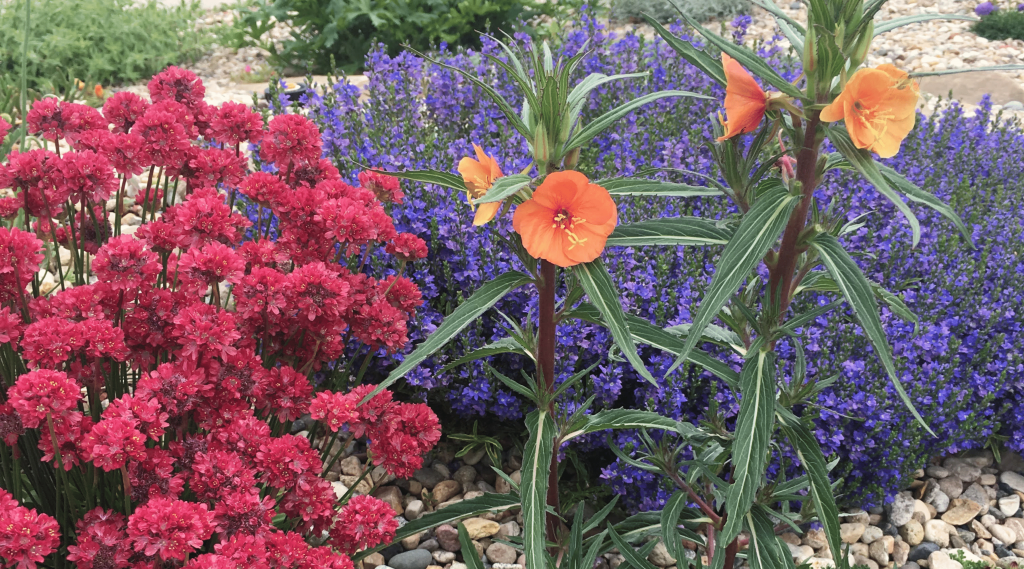
Winter Watering on the Front Range
Our often dry, windy winters here on the Front Range can be especially tough on landscaping plants such as perennials, trees, shrubs, and lawns. Most plants need moisture throughout the winter to prevent root damage, so developing a winter watering schedule can help to protect your landscaping.
If roots are damaged over the winter, the “winter kill” is not obvious until summer. A plant or lawn may green up nicely in the spring, but in the first hot days of summer, a plant with damaged roots will struggle to take up enough water. This affects the health of the entire plant and can result in the browning of foliage (especially in evergreens and lawns). A weakened plant is more susceptible to pest and disease damage, and in severe cases, the entire plant may die from winter kill. Because our winters often lack consistent precipitation, many plants will benefit from supplemental winter watering.
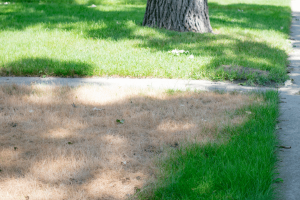
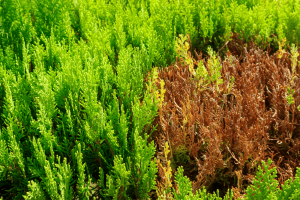
What plants benefit from winter watering?
Nearly all plants will benefit from winter watering. However, the following plants are especially sensitive to drought injury throughout the winter.
- Recent Transplants
- Plants that are less established have smaller root systems and need more supplemental water to thrive.
- According to Colorado State University Extension, trees take one year to establish for each inch of trunk diameter at planting.
- Bare root plants take longer to establish than container plants.
- Plants transplanted later in the season take longer to establish.
- Evergreens
- Because evergreens retain their needles, they still transpire throughout the winter. Without adequate soil moisture to replace this water loss, evergreens are at a higher risk for winter burn.
- Evergreens at highest risk include arborvitae, boxwood, fir, Manhattan euonymus, non-native pines, Oregon grape-holly, spruce, and yew.
- To help limit desiccation, some evergreens can be treated with a product such as Wilt Pruf® or Bonide Wilt-Stop®. Read the product label for uses and instructions.
- Deciduous Trees and Shrubs with shallow root systems
- Woody plants with shallow root systems are more likely to dry out because they cannot pull water from deep in the ground.
- These include alders, European white and paper birches, dogwoods, hornbeams, lindens, mountain ashes, willows and several varieties of maple including Norway, silver, red, Rocky Mountain, and hybrid maples.
- Herbaceous Perennials and Ground Covers
- Even established perennials and ground covers can suffer from winter kill, especially those without wind protection and those with south or west exposures that experience more freezing and thawing.
- Lawns
- Newly established lawns are especially at risk for winter kill as well as those with south or west exposures.
When should I winter water?
Most plants will benefit from winter watering from October through March.
According to Colorado State University Extension, water one to two times per month during dry periods without snow cover. Windy or sunny sites (those with south or west exposures) dry out quicker and will require more water.
Only water when air temperatures are above 40°F and the soil is not frozen or covered in snow.
Water mid-day or earlier to ensure the water has time to fully soak in before freezing at night. Test soil moisture before watering by inserting a probe or screwdriver into the soil. If the screwdriver goes in easily, watering is not necessary. However, if it is difficult to push the screwdriver in after a few inches, watering is necessary.
What is the best way to apply water during winter?
While water can be applied by hand, typically it is most efficient to water with a soaker hose, drip hose or sprinkler that attaches to a hose. (Do not use an in-ground sprinkler system as these should stay winterized until spring.)
Trees can also be watered using a deep-root fork or needle that is inserted no deeper than eight inches into the soil in multiple locations throughout the dripline and outside of it. As with watering in the summer, it is important to allow water to slowly soak into the soil. This results in deeper penetration and prevents runoff. For trees, water should penetrate to a depth of 12 inches.
How much water do my plants need?
Mulch is crucial to helping soil retain moisture. The following recommendations assume that all plants have at least two inches of mulch. Keep in mind that most sprinklers deliver approximately 2 gallons of water per minute.
Trees
- Apply at least 10 gallons of water for each diameter inch of the tree
- Water once a month (twice a month for newly planted trees)
- Water from the edge of the branches halfway to the trunk, and then two to three times that distance from the edge of the branches outward
Shrubs
- Newly Planted: Apply at least 5 gallons of water twice a month
- Small, established (less than 3 feet tall): Apply at least 3 gallons of water once a month
- Large, established (more than 6 feet tall): Apply at least 10 gallons of water once a month
- Water within the dripline and around the base
Herbaceous Perennials
- Water requirements vary based on level of establishment and size of the plant
- As a general guideline, apply half the amount of water that would be applied in a typical summer watering session once a month
Lawns
- Water lawns if there has been no precipitation for three weeks and the lawn has a south or west exposure
- Apply half the amount of water that would be applied in a typical summer watering session
Resources
https://water.unl.edu/article/lawns-gardens-landscapes/winter-watering
Caring for Evergreen Wreaths & Garland
Use these three tricks to keeping evergreen wreaths and garlands looking fresh.
Fully hydrate the greenery prior to displaying it
Water is primarily absorbed through the cut ends of the branches. It has likely been a few days since your greenery had a good drink of water, so fully hydrate your wreath or garland for a few hours or even overnight before you display it. This can be accomplished by putting an inch or two of water in a bathtub (or other container) and laying the greenery flat in it. If available, laying the wreath in snow overnight will work just as well.
Prevent moisture loss by choosing an ideal location
Fresh cut greenery does best in cool, shady locations. Outside is ideal! Whether displayed outside or inside, exposure to direct sun will shorten the lifespan. If you choose to display your wreath or garland indoors, choose a spot away from sources of heat (fireplaces, heaters, heat vents, etc.) as these will quickly dry out the greenery.
Keep your greenery hydrated
Mist the back of your greenery with water daily in our dry Colorado climate. This will help the cut ends of the greenery to absorb moisture. Greenery displayed indoors will benefit from a nearby humidifier. Anti-transpirant sprays such as Bonide c or Wilt-Pruf® can also be applied to greenery to reduce transpiration of moisture.
The lifespan of your greenery will be dictated by how much moisture it loses and how much it is able to absorb. The more hydrated your greenery is, the fresher it will look and the longer it will last.
Bonide Wilt Stop®: https://www.ricksgarden.com/product/bonide-wilt-stop-rtu-40fl-oz/
Wilt-Pruf®: https://www.ricksgarden.com/product/15035/
Caring for a Real Christmas Tree
Fresh Christmas trees require a little more care than fake ones, but their beauty and lowered environmental impact are worth it!
Choosing the Best Spot
Just as with cut flowers in a vase, the trick to keeping real trees looking good is to keep them from drying out. Trees should be kept away from major sources of heat (fireplaces, heaters, heat vents, direct sunlight) as these will dry out your tree faster. Cooler room temperatures will also help to slow down moisture loss.
Measuring the Spot
Avoid a Clark Griswold moment – know the size of your space and be sure to choose a tree that will fit. When viewing trees outside against a big open space, they often seem smaller. Some trees are narrow, while others can be quite wide, so consider both height and width when measuring.
Choosing the Best Tree Stand
Think of your tree stand as a vase for flowers. It needs to hold the tree upright and hold ample amounts of water. Here are a few factors to consider:
- Size – Trees can vary in size from 3’ tall to over 12’ tall, so choose a tree stand that is appropriate for the size of tree you intend to put in it. Shaving off the sides of the trunk to fit in a stand that is too small will decrease the tree’s ability to take up water.
- Stability – Taller trees need more stability and thus stronger legs that extend out further.
- Water Capacity – Be sure the stand can hold enough water, at least 1 quart of water for every inch of trunk diameter. The water will need to be checked daily (twice daily the first few days) so choose a stand that is accessible.
Pro Tip: Slip a biodegradable plastic tree bag over the trunk before attaching the tree stand. Spread the bag out under the tree skirt. When the holidays are done, you can pull the bag up over the tree and easily carry it outside without scattering needles throughout the house.
Planning for Decorations
Consider your style before choosing a tree. Some varieties of trees are dense and bushy, so only the outer tips of the branches can be decorated. Other varieties have a more open form, allowing the inner branches to be decorated as well. If you plan to put heavy ornaments on your tree, be sure to choose a tree variety known for having strong branches. Lights that produce heat can also dry out a tree faster, so opt for cooler lights whenever possible.
Not sure which variety is best for you? Check out our blog post on choosing a tree variety.
Recutting the Trunk
To help your tree take up water, all trees should be given a fresh cut (½” removed from the trunk) and then put in water as quickly as possible (the quicker the better, but some species can go as long as 6 to 8 hours and still take up water). Once the tree is given a fresh cut, it is important to not bruise the cut or get the cut dirty as this will plug the cells and prevent the uptake of water.
Here at Rick’s we will give each tree a fresh cut before the tree leaves the lot. We can even put your tree stand on your tree for you so that when you get home, all you need to do is add water!
If you will not be able to set up your tree right away, store it in a cool location out of the wind in a bucket that is kept full of water.
Caring for Your Tree
Trees can take up a surprising amount of water – sometimes more than a gallon a day in the first few days. It is important to keep filling the tree stand with water. If the tree runs out of water, the cut will dry out, resin will block the pores, and the tree will lose the ability to take up water. Check the water twice a day the first week, and then daily after that.
Safety
Choose lights that are cool to the touch (modern LED lighting is an excellent choice). Inspect lights prior to putting them on the tree and replace them if they are worn out. Check the label on your set of lights to find out how many strands can be connected and do not overload electrical circuits. Keep the tree away from heat sources including candles and fireplaces. Turn off the Christmas tree lights every night before bed. When the tree dries out, it is time to dispose of it.
Tree Disposal
Christmas trees can be recycled at facilities that process them into mulch. More information on the mulching program in Colorado Springs can be found online at TreeCycleCOS.org
Related Products
Pursell Tree Preservative – Liquid: https://www.ricksgarden.com/product/pursell-christmas-tree-preservative-8oz/
Pursell Tree Preservative – Granular: https://www.ricksgarden.com/product/pursell-christmas-tree-preservative-granular-0-5oz/
Tree Disposal Bag: https://www.ricksgarden.com/product/pursell-christmas-tree-disposal-bag/
Bonide Wilt Stop®: https://www.ricksgarden.com/product/bonide-wilt-stop-rtu-40fl-oz/
Wilt-Pruf®: https://www.ricksgarden.com/product/15035/
Resources
https://www.extension.purdue.edu/extmedia/fnr/fnr-423-w.pdf
https://realchristmastrees.org/all-about-trees/care-tips/
https://www.christmastreeassociation.org/fire-safety-tips-for-your-christmas-tree/
Choosing a Christmas Tree Variety
Questions to Consider
Do you want a fuller tree (one with dense branches) or a more open tree (one with more spacious branches)?
If you like the look of a bushy tree, choose a fuller type. If you like to decorate the interior of the tree, use larger ornaments, or be able to see through the tree, then choose a more open tree type.
Do you tend to decorate with heavy ornaments?
If you use heavy ornaments, be sure to choose a tree variety with strong branches.
Does scent matter to you?
Some varieties are very fragrant while others only have a light scent.
How long do you plan to display your tree for?
If you plan to display your tree for several weeks, be sure you choose a variety with good needle retention. Ensuring that trees are placed in cooler locations, far from heating vents (which dry trees out) will also help with needle retention. Checking on the water levels of the tree daily and watering as needed is also critical. If the tree runs out of water, the cut will dry out, resin will block the pores, and the tree will lose the ability to take up water. Additional products such as tree preservatives and Wilt Pruf or Wilt Stop can help extend the life of the tree.
How much do you want to spend?
At Rick’s, we only carry premium quality Christmas trees. Our tree prices are based on two main factors – size and the cost of producing that tree variety. Larger trees are more expensive as are varieties of trees that are slower growing (and therefore take longer to produce).
Overall Attributes
There are three main types of evergreen trees sold as Christmas trees – firs, spruce, and pines.

Firs
Soft needles, fragrant, strong branches
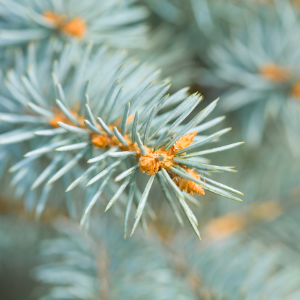
Spruces
Spiky needles (good for repelling cats), very strong branches, fuller/wider
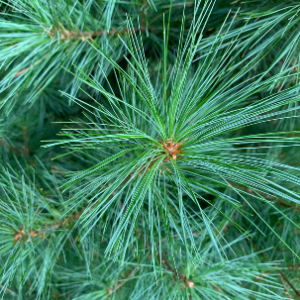
Pines
Long soft needles, unique elegant shape, less dense (more open) branches
Christmas Tree Accolades
Longest Lasting
Fraser Fir & White Fir
Honorable Mentions: Scotch Pine, Balsam fir, White Pine
Best at Repelling Pets
Blue Spruce
Most Traditional Christmas Tree Look
Noble Fir
Honorable Mention: Scotch Pine
Strongest Ornament Holder
Blue Spruce
Honorable Mentions: Balsam Fir, Fraser Fir, Noble Fir
Longest Needles
White Pine & Scotch Pine
Strongest Scent
Balsam Fir (strong) & Fraser Fir (pleasant)
Christmas Tree Variety Details
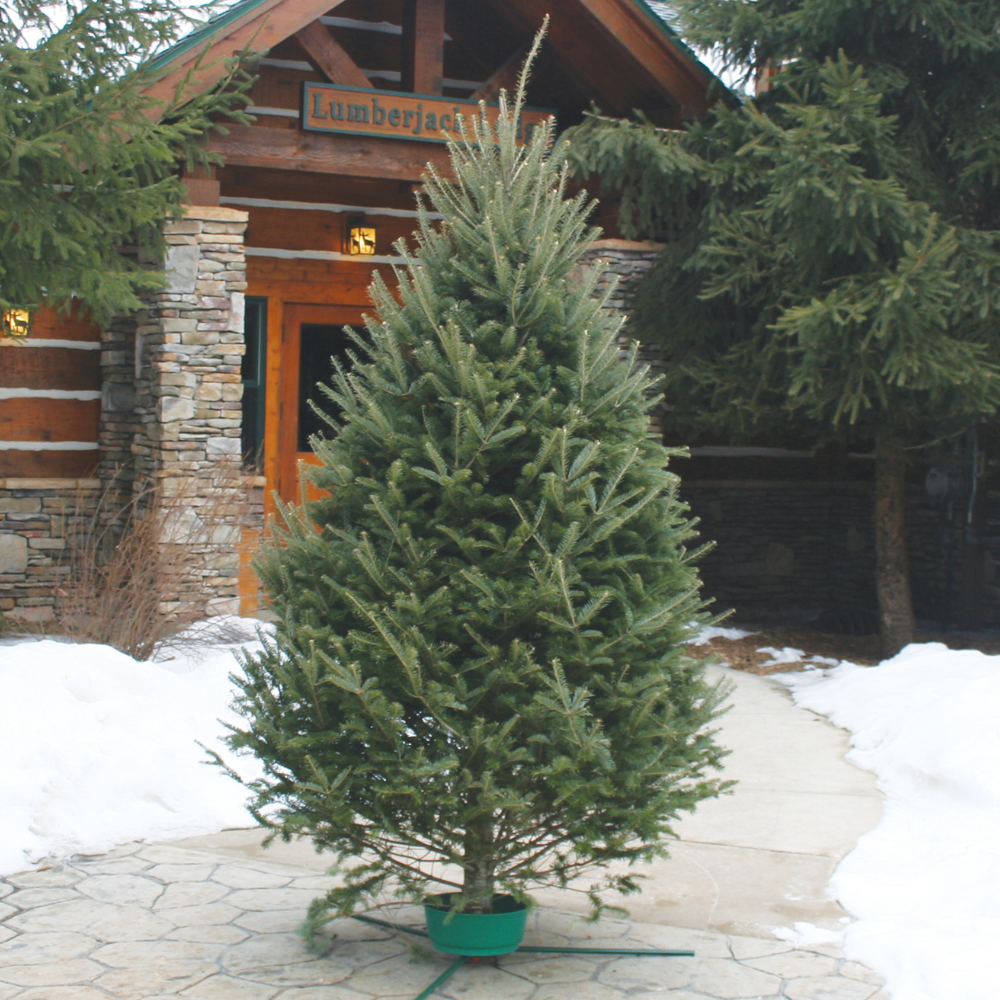
Balsam Fir
Balsam firs have fragrant, dark green foliage and are known for their strong branches and soft needles. Balsam firs have excellent needle retention and retain their pleasing scent throughout the holiday season.
Foliage Color: Dark Green
Needle Type: Soft
Needle Retention: Excellent
Branches: Strong and point straight out from the trunk
Overall Shape: Not too narrow, not to wide, right in the middle
Scent: Fragrant “Christmas tree” scent, retains scent throughout the holiday season
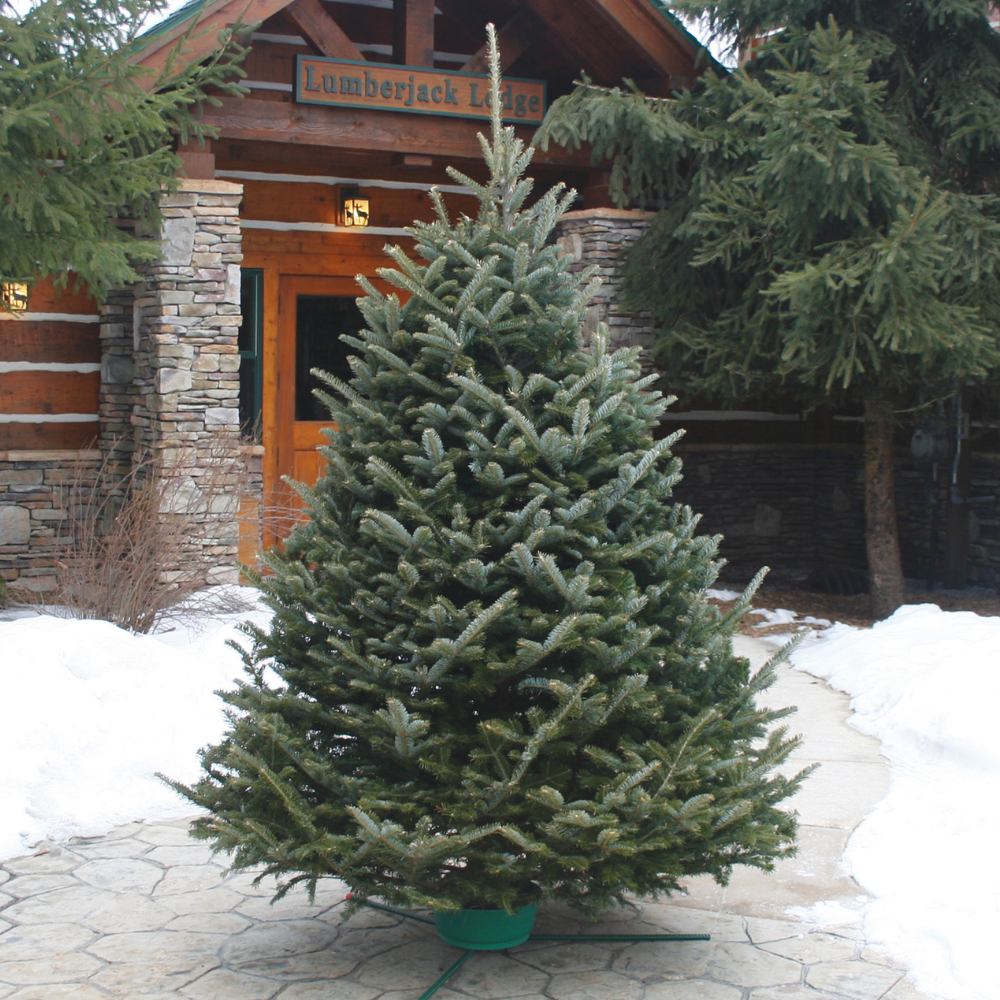
Fraser Fir
Fraser firs have dark green needles with a frosty glow and pleasing fragrance. They are beautifully shaped with strong, slightly upturned branches and excellent needle retention. Fraser firs are considered one of the most desirable Christmas trees in North America.
Foliage Color: Dark Green, frosty underlying glow
Needle Type: Soft and upright
Needle Retention: Excellent, very long lasting
Branches: Strong and point slightly upward, can be dense
Overall Shape: Fuller than a Balsam, but not as full as a Noble or Nordman
Scent: Pleasant scent, retains scent throughout the holiday season
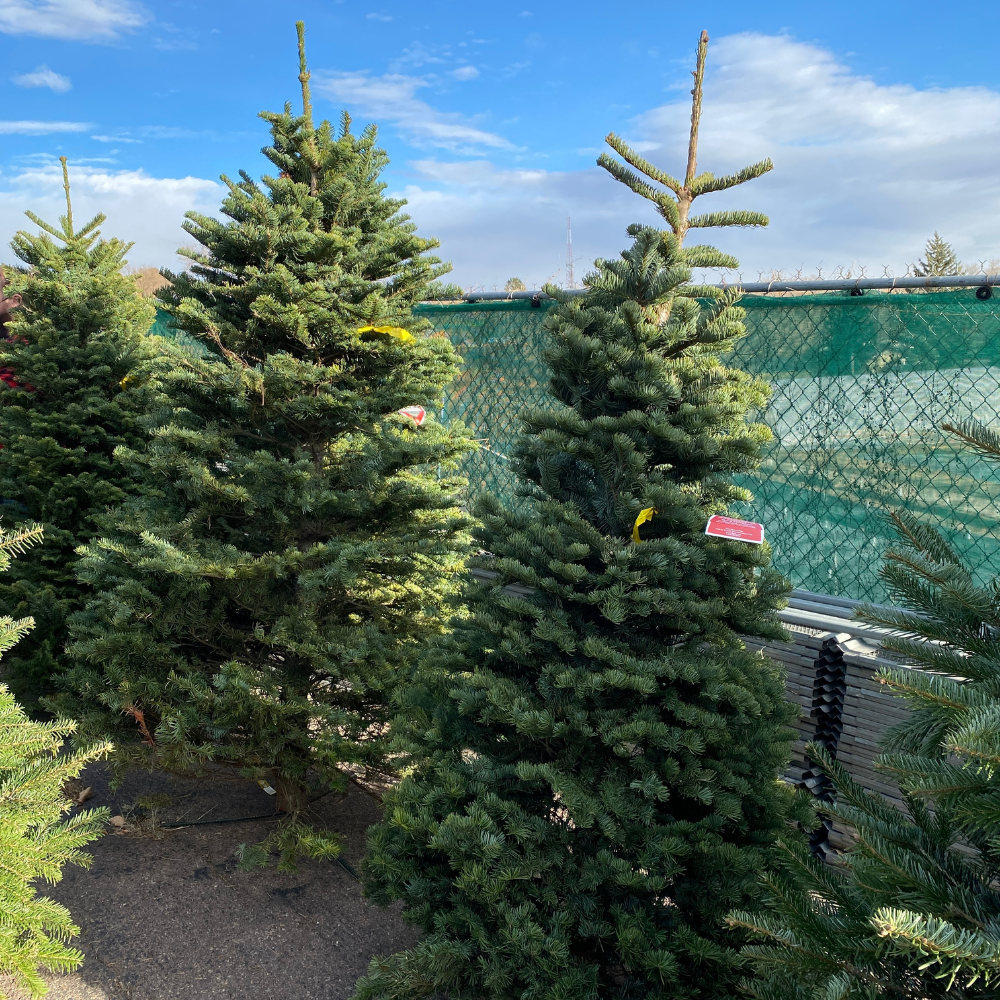
Noble Fir
Known as “America’s Christmas tree,” the Noble fir is one of the loveliest Christmas trees we carry. These slow growers have beautiful dark green foliage with bushy branches that are strong and straight.
Foliage Color: Dark Green
Needle Type: Soft
Needle Retention: Good
Branches: Strong, point straight out from the trunk, good spacing between branches
Overall Shape: Very full
Scent: Light fragrance
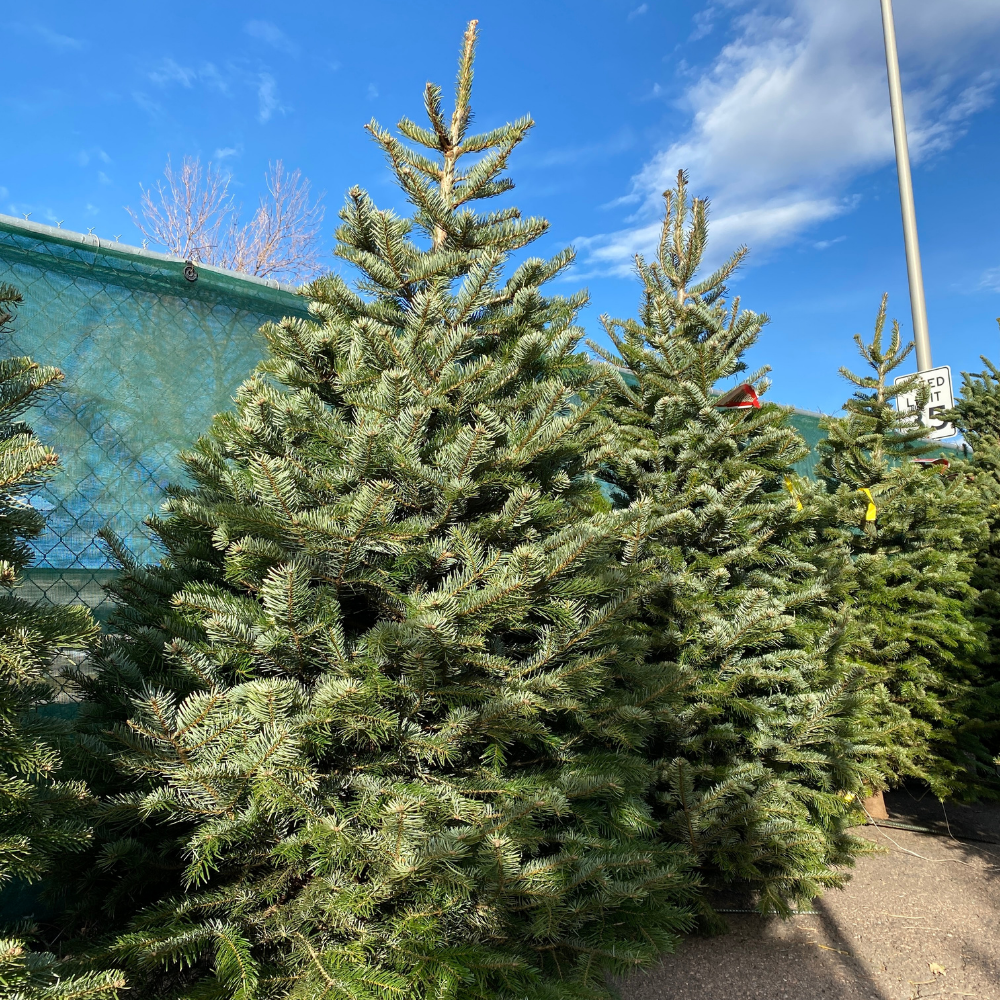
Nordman Fir
The Nordman fir is a very full, wide tree and has the softest needles of any tree we carry. It has a low fragrance level and beautiful symmetry.
Foliage Color: Dark Green, frosty underlying glow
Needle Type: Softest of them all
Needle Retention: Good
Branches: Good strength for average ornaments
Overall Shape: Very full, heavy trees, nice cone shape
Scent: Light fragrance
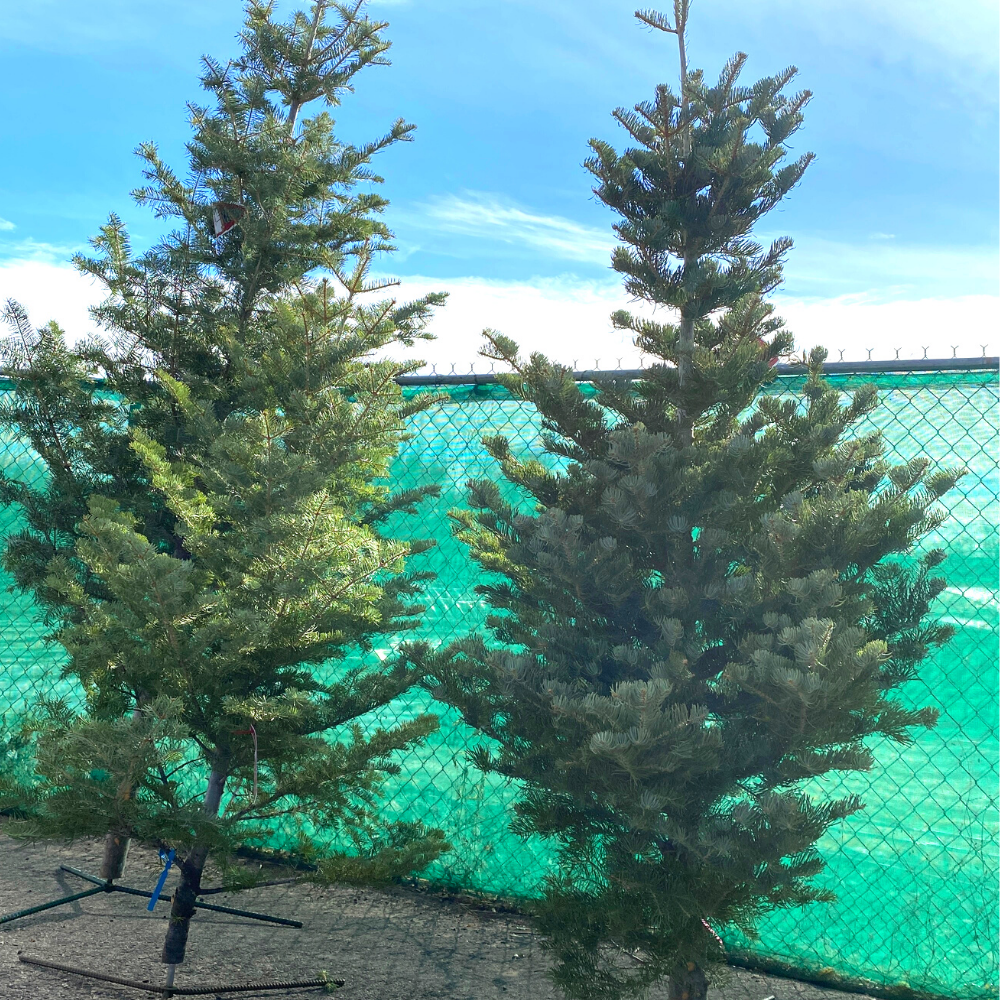
White Fir
Our white firs are sourced from forest thinning efforts in New Mexico, making them an environmentally conscious choice. Because they are not farmed, these trees have a more rustic, natural shape with beautiful soft, light-green foliage.
Foliage Color: Light green
Needle Type: Long and soft
Needle Retention: Excellent
Branches: Strong, open spacing
Overall Shape: These trees are harvested, not farmed, and have a more natural shape
Scent: Fragrant
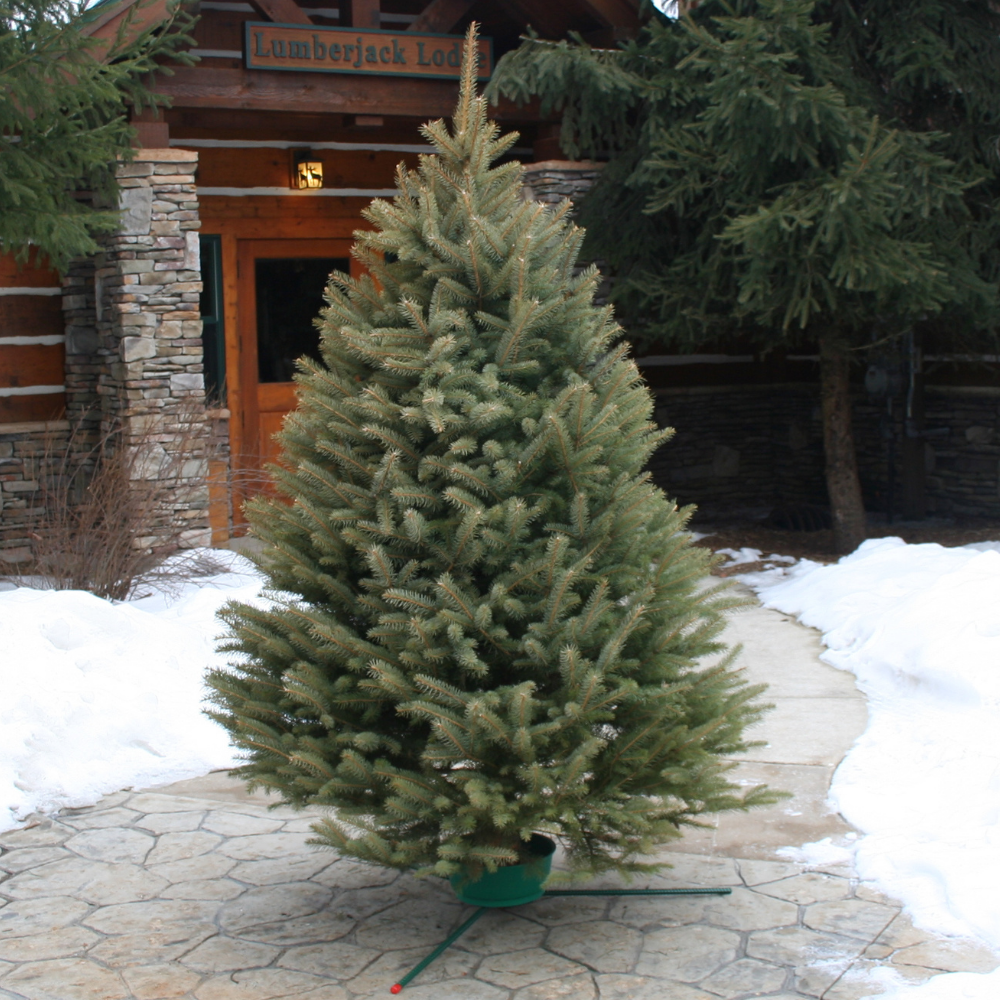
Colorado Blue Spruce
Blue spruces are known for their striking foliage that can be bluish green to silvery blue. A slow grower, the blue spruce has stiff, strong branches and a desirable pyramidal shape. The needles are spiky and may repel cats who are prone to tree climbing.
Foliage Color: Blue-green to powdery silver
Needle Type: Spiky, may repel pets
Needle Retention: Needles may drop in a warm environment
Branches: Stiff and strong
Overall Shape: Very full and wide
Scent: Stronger scent
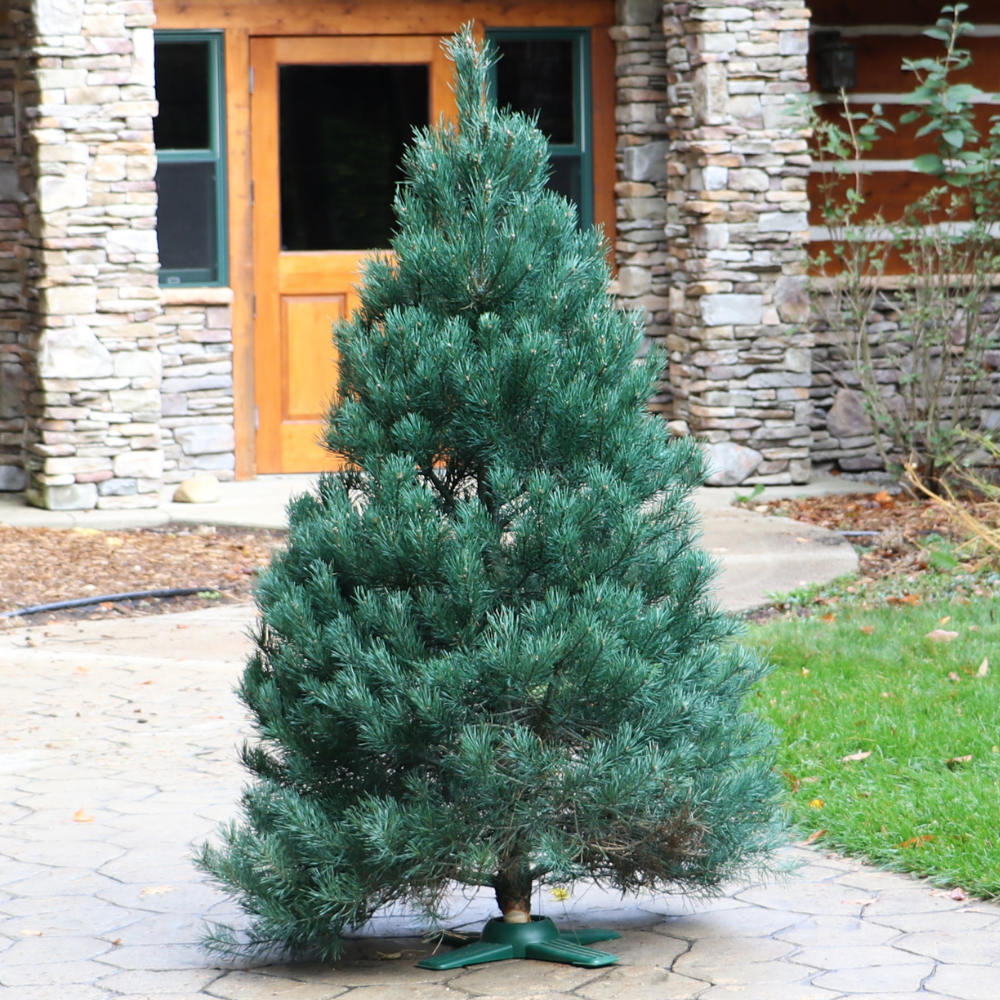
Scotch Pine
Scotch pines are a traditional favorite due to their economical price and incomparable needle retention. The branches are strong with bright green, medium length needles that will not drop even if the tree becomes dry, making it an excellent choice for warmer homes.
Foliage Color: Dark green
Needles: Stiff, one inch long
Needle Retention: Excellent (incomparable!) Needles will stay on even when dry
Branches: Stiff
Overall Shape: Open appearance with more room for ornaments
Scent: Fragrant, maintains scent throughout the season
Notes: Easier to grow, very economical
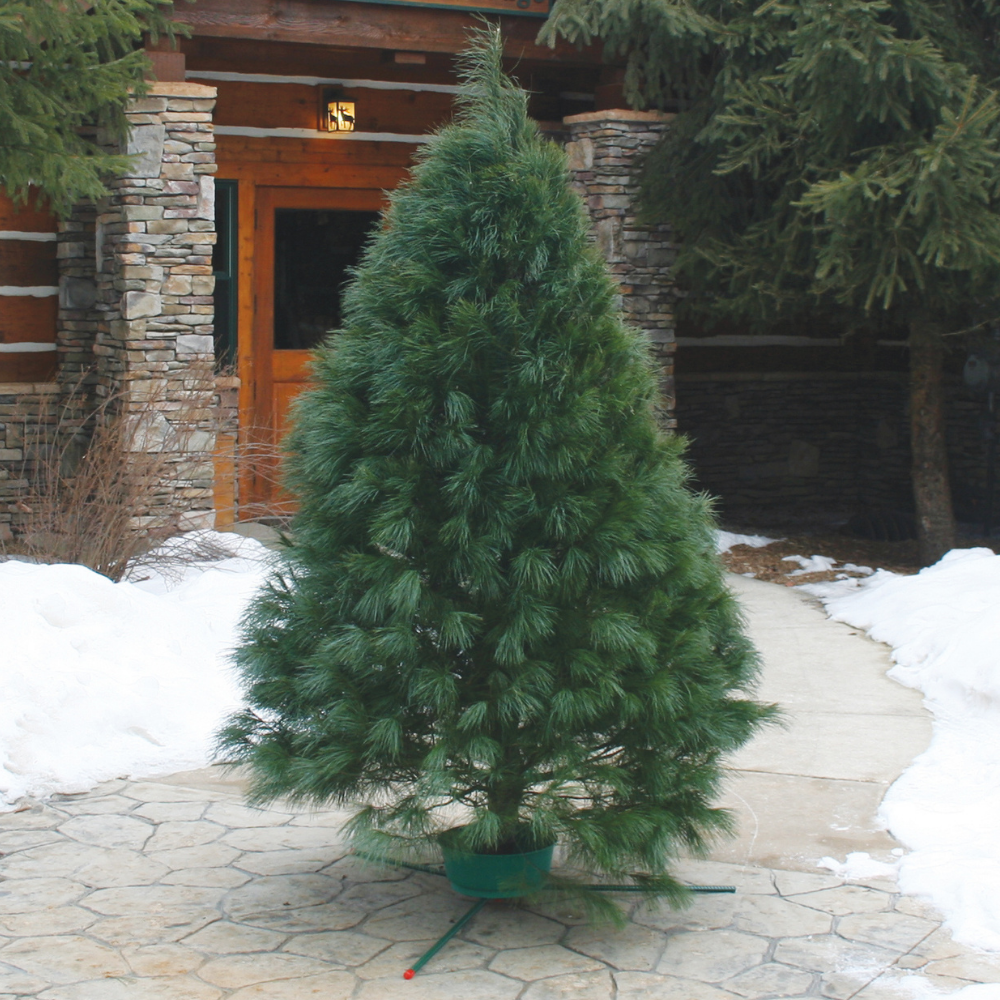
White Pine
White pine Christmas trees have long, soft, bluish-green needles and excellent needle retention. This tree is known for its elegant, symmetrical shape.
Foliage Color: Bluish-green
Needles: Long and soft, very elegant
Needle Retention: Excellent
Branches: Wispy branches with open space between them, does best with lighter ornaments
Overall Shape: Open appearance with more room for ornaments
Scent: Very little aroma
Resources
https://web.extension.illinois.edu/trees/types.cfm
https://www.canr.msu.edu/news/choosing_the_right_christmas_tree
Fall Perennial Planting
Planting in the fall can save you a lot of money while also giving plants a jump start next spring! Plants that establish strong roots during the fall will come back bigger and stronger in the spring time.
However, fall planting requires careful consideration and attention to detail from the gardener. The trick is to give fall plantings a little extra care to help them get established before the really cold weather sets in.
Here are four things you can do to help your plants get established:
Soil Inoculant
At the time of planting, be sure to use an inoculant specifically formulated for perennials, trees and shrubs. These products will help the plant to start establishing roots before all of the foliage dies back. We recommend using an inoculant over a root stimulator this late in the season so you can avoid giving any extra nitrogen to the plant before it goes in to dormancy.
Mulch
Mulch helps to retain soil moisture while also protecting roots from sudden changes in temperature. We recommend using 3″ of a good quality mulch to keep plants protected. Make sure that mulch does not contact the bark of woody perennials.
Protect Plants from Early Freezes
Keep an eye on the weather and cover the plants when the temperatures dip below freezing throughout September and October. This is most important for perennials. Trees do not need to be blanketed, but bark wrap should be used on all young trees to protect the trunks from splitting during our freezing and thawing cycles. When covering perennials, use heavy fabric or plastic and prop it up so that it is close to, but does not touch the plant (Plastic that touches the plant during a freeze can actually do more damage.) Be sure the covering goes all the way to the ground and cover the edges with soil or mulch so that it will trap heat from the soil.
Water
To support adequate root growth, plants will need to be watered regularly in the fall. Keep your soil evenly moist, but not soggy, through the fall time. Remember to monitor your plants regularly! A plant that crisps up due to lack of water in the fall time is not likely to survive the winter. When the plant goes dormant, they will require less frequent watering, but will also need to be watered throughout the winter. Remember that desiccation is the result of cold weather plus dry soil. For more details on winter watering, visit our Blog.
Rick’s Deer Resistant Plant List
A Note About Deer Resistant Plants
The plants listed here are not guaranteed to be deer resistant. This is merely a guide of what deer generally do not eat. If they are hungry enough, they will eat just about anything, and it can vary from one side of town to the other.
Anything marked with a * indicates plants are browsed occasionally, but typically not destroyed.
The best protection against deer damage is an eight-foot-high fence.
Perennials
Apache Plume (Fallugia paradoxa)
Baby’s Breath (Gypsophilia paniculata)
Basket of Gold (Alyssum saxatile)*
Bee Balm (Monarda)
Bergenia (Bergenia)
Black-eyed Susan (Rudbeckia fulgida)
Blanket Flower (Gaillardia)
Bleeding Heart (Dicentra spectabilis)
Blue Star (Amsonia)
Butterfly Bush (Buddleia)
Butterfly Weed (Asclepias)
Cacti (Cacti: var genera & ssp.)
Catmint (Nepeta)
Chocolate Flower (Berlandiera lyrata)
Coreopsis (Coreopsis)*
Cranesbill, Wild Geranium (Geranium ssp.)*
Creeping Phlox (Phlox subulata)
Daffodils (Narcissus ssp.)*
Delphinium (Delphinium ssp.)*
Dotted Gayfeather (Liatris punctata)
Dwarf Leadplant (Amorpha)
Globe Thistle (Echinops ssp.)
Euphorbia (Euphorbia ssp.)
False Forget-Me-Not (Brunnera macrophylla)
Flax (Linum ssp.)*
Forget-Me-Not (Mertensia ssp.)
Foxglove (Digitalis)
Golden Banner (Thermopsis ssp.)
Goldenrod (Solidago ssp.)
Hummingbird Plant (Zauschneria)
Hyssop (Agastache)
Iris (Iris ssp.)*
Japanese Painted Fern (Athyrium niponicum)
Lady Fern (Athyrium filix-fernina)
Lady’s Mantle (Alchemilla)
Lamb’s Ear (Stachys)
Larkspur (Consolida)
Lavender (Lavandula ssp.)
Leadplant (Amorpha canescens)
Lenten Rose (Helleborus ssp.)
Lily of the Valley (Convallaria majalis)
Lupine (Lupinus)*
Mexican Hat Coneflower (Ratibida columnifera)
Monkshood (Aconitum)
Penstemon (Penstemon ssp.)*
Peony (Paeonia ssp.)
Poker Plant (Kniphofia ssp.)
Poppy, esp. Oriental (Papaver)*
Prairie Zinnia (Zinnia grandiflora)
Prickly Pear (Opuntia ssp.)
Purple Coneflower (Echinacea purpurea)
Purple Prairie Clover (Dalea purpurea)
Rose Champion (Lychnis)
Russian Sage (Perovskia atriplicifolia)*
Santolina (Santolia ssp.)
Sedum (Sedum ssp.)
Shasta Daisy (Leucanthemum ssp.)*
Silver Nettle (Lamium)
Sneezeweed (Helenium)
Snowdrops (Galanthus ssp.)
Snow-in-Summer (Cerastium tomentosum)
Snow-on-the-Mountain (Euphorbia marginata)
Soapwort (Saponaria ssp.)
Speedwell (Creeping veronica)
St. John’s Wort (Hypericum)
Sweet William (Dianthus barbatus)*
Sweet Woodruff (Galium odoratum)
Wormwood (Artemisia)
Yarrows (Achillea ssp.)
Yucca (flowers eaten) (Yucca ssp.)
Bushes & Shrubs
Buffaloberry, Silver (Sheperdia argentea)
Burning Bush (Euonymus)*
Chokecherry (Prunus virginiana)*
Cliff Rose (Cowania neo-mexicana)
Coralberry, Hancock (Symphoricarpos x ‘Hancock’)
Currant, Alpine (Ribes aplinum)
Currant, Golden (Ribes aureum)*
Daphne
Dogwood, Redtwig (Cornus stolonifera)*
Euonymus, Winged (Euonymus alatus)
Fernbush (Chamaebatiaria millefolium)
Grapeholly, Oregon (Mahonia aquifolium)
Lilacs (Syringa ssp.)*
Mahonia, Creeping (Mahonia repens)
Mountain Mahagony, Curl-leaf (Cercocarpus ledifolius)
Ninebark, El Diablo (Physocarpus monogynus)*
Oak, Gambel’s (Quercus gambelii)
Plum, Wild (Prunus americana)
Potentilla (Potentilla ssp.)
Pyracantha (Pyracantha ssp.)
Quince (Chaenomeles ssp.)
Rabbitbrush (Chrysothamnus ssp.)
Raspberry, Boulder (Rubus deliciosus)
Rose, Austrian Copper (Rosa foetida ‘bicolor’)
Rose, Persian Yellow (Rosa foetida ‘persiana’)
Rose of Sharon (Hibiscus syriacus)*
Sage, Big Western (Artemisia tridentata)*
Saltbush, Four-wing (Atriplex canescens)
Snowberry (Symphoricarpos albus)
Spirea, Anthony Waterer (Spirea ‘anthony waterer’)
Spirea, Bluemist (Caryopteris incana)
Spirea, Rock (Holodiscus dumosus)
Spirea, VanHoutte (Spiraea x vanhouttei)
Sumac, Fragrant (Rhus trilobata)*
Vines & Groundcover
Bugleweed (Ajuga reptans)
Clematis, Golden Tiara (Clematis tangutica)
Clematis, Sweet Autumn (Clematis paniculata)
Clematis, Western White (Clematis ligusticifolia)
English Ivy (Hedera Helix)
Honeysuckle, Tatarian (Lonicera tatarica)
Iceplant (Delosperma)*
Kinnikinnick (Arctostaphylos uva-ursi)
Pussytoes (Antennaria speciosa)
Virginia Creeper (Parthenocissus quinquefolia)
Annuals
Ageratum
Angelonia
Begonias*
Cleome
Cosmos (Cosmos)
Lantana
Marigold (Tagetes)
Nasturtium (Tropaeolum)
Persian Shield (Strobilanthes dyerianus)
Portulaca
Salvia
Snapdragon (Antirrhinum)
Tobacco Flower (Nicotiana)
Torenia
Verbena
Grasses
Blue Fescue (Festuca)
Feather Reed (Calamagrostis)
Fountain Grass (Pennisetum)
Little Bluestem (Schizachyrium)
Maiden Grass (Miscanthus)
Quaking Grass (Briza)
Sedge (Carex)
Switch Grass (Panicum)
Bulbs – Fall Planting
Allium (Alluim)
Fritillaria (Fritillaria)
Grape Hyacinth (Muscari)
Hyacinth (Hyacinthus)
Daffodil (Narcissus)
Bulbs – Spring Planting
Calla Lily (Zantedschia aethiopica)
Canna Lily (Canna)
Dahlia (Dahlia)
Dwarf Iris (Iris reticulata)
Gladiolus (Gladiolus)
Lily of the Valley (Convallaria majalis)
Vegetables, Herbs, Fruits
Allium – Chives, Onions, Leeks, Garlic
Basil
Blueberry
Chamomile
Coriander (Cilantro)
Dill
Elderberry
Fennel
Feverfew
Germander
Globe Artichoke
Lemon Balm
Marjoram
Mints
Oregano
Parsley
Potatoes
Rhubarb
Rosemary
Salvia (cooking sage)
Savory
Squash Thyme
Trees
Cherry, Nanking (Prunus tomentosum)
Fir, Concolor (Abies concolor)
Fir, Douglas (Pseudotsuga taxifolia)
Hackberry, Common (Celtis occidentalis)
Hawthorn (Crateagus spp)
Honeylocust (Gleditsia triacanthos var.)
Juniper, Common (Juniperus communis)
Maple, Rocky Mountain (Acer glabrum)
Pine, Lodgepole (Pinus contorta)
Pine, Pinon (Pinus edulis)
Russian Olive (seeds eaten) (Elaeagnus angustifolia)
Spruce, Colorado (Picea pungens)
Tree and Shrub Planting Guide
Tree & Shrub Planting Guide
Call before you dig! Dial 811
1. Measure the depth of the root ball. Your planting hole should be approximately one inch less in depth than the root ball itself (Example: 14” root ball should be planted in a 13” deep hole). Lay your rake or shovel handle across the hole, the root ball should be just slightly higher than the handle. The tree should sit on undisturbed, firm, soil. You need a firm foundation so the tree doesn’t settle after it is planted.
2. Dig a large saucer shaped hole approximately 3 times the diameter of the root ball (Example: the root ball is 16” across, the diameter of the hole should be 48”). The saucer shaped sides of the planting hole help the new root growth to move outward and upward, away from the trunk or crown. This helps prevent the new roots from girdling the trunk and maintains proper oxygen and nutrient flow to the root system.
3. Gently remove container, for large trees or shrubs, it may be easier to cut the container off. DO NOT pick up the tree or shrub by its trunk and attempt to “shake” off the container.
4. Check the root ball for roots that are growing in a circular pattern. If the roots are “Pot Bound” it is recommended to shave off an inch to an inch and a half of the exterior of the root ball. Use a hand saw to slice off strips from the exterior of the root ball around the perimeter. Prune any remaining circling roots. This has been found to be more effective than vertical slices through the root ball and prevents root girdling of the tree. Do this in several sections around the root ball. This will stimulate the roots to begin growing out of their circulating pattern.
5. Dust the root ball and cut root ends with a mycorrhizae inoculant, such as Mykes, Soil Moist or other product, so that there is good contact with the root system per the product directions. If possible, dampen the root ball to help adhere the dust to the root ball.
6. Place the tree in the hole and backfill with the original soil, remove any large dirt clumps or rocks. Water in the soil to settle it down, do not tamp down. Continue backfilling up to the top of the root ball. If you have any excess soil, use it to build a raised berm around the outside of the hole. This will aid in proper watering. NOTE: If you have heavy clay soil, consult our Nursery Manager. It is NOT recommended to try and adapt trees to soil they cannot tolerate.
7. Mix the Ferti-lome Root Stimulator or Bonide Root & Grow according to the directions on the label. Water the tree or shrub thoroughly with the mixture throughout the first two growing seasons.
8. Add mulch to the planting area, keeping the mulch 4-6 inches from the trunk of the tree or crown of the shrub. This will help retain moisture, moderate the soil temperature and prevent mower/trimmer damage, ensuring a good consistent growing area for your new plant. It looks great too!
9. Large, tall trees will require staking and guying. This will prevent any wind damage that could topple or shift your tree causing severe root damage. Tree straps should be loose to allow the tree to move a little in the wind. Remove tree straps after one year.
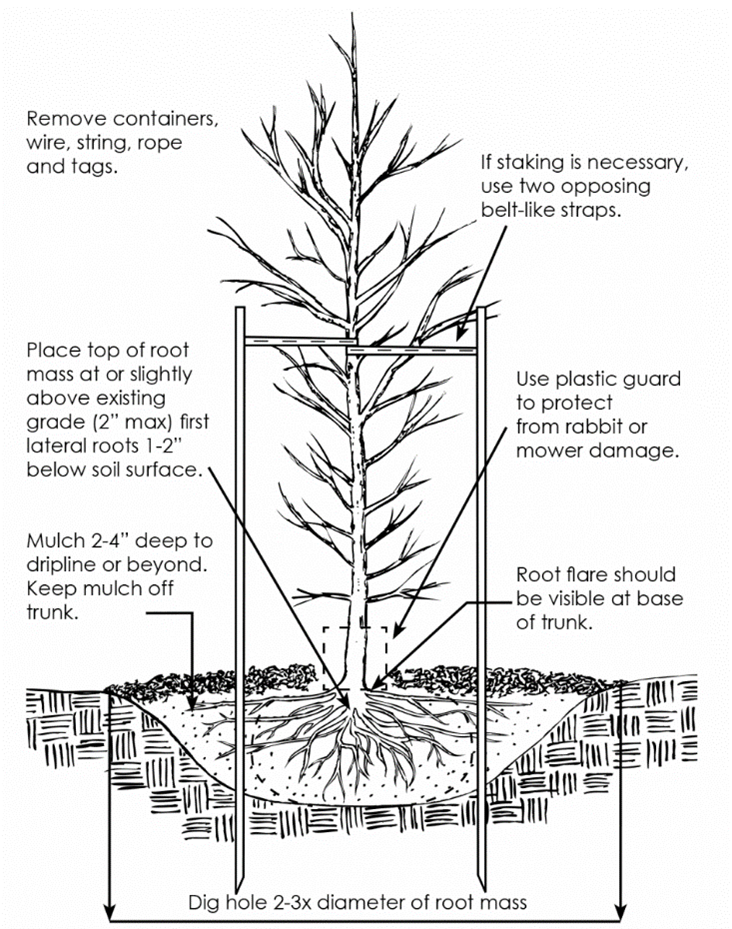
RECOMMENDED:
TREE WRAP We highly recommend using tree wrap on any smooth barked /and/ or dark colored tree trunks. Winter sun can cause frost cracking in young trees, especially trees with southwest exposures. Wrapping should be applied around Thanksgiving and removed by April Fools Day or Easter.
TRUNK BARK PROTECTORS The only trees that may not need Deer Guards are those planted behind a 6’ fence that the deer can’t see through; or have thick rough bark! It is never worth risking the damage that deer WILL do! This can also protect against mechanical damage from mowers.
WATERING:
Newly planted trees will need 5-10 gallons of water a week for the first two years until they are established. It is better to water more deeply and infrequently than lightly and frequently. If the soil is still wet a couple of inches down around the root ball, avoid watering.
Don’t forget to Winter Water!! Trees still lose moisture during the dormant period. If there has been no measurable precipitation for over a week and temperatures are above freezing, water lightly once a week, 2-3 gallons. This goes a long way to preventing winter dye-back and root damage!
Tillandsia (Air Plant) Care
Tillandsia species are wonderful indoor houseplants that add a fun and exciting flare to your décor.
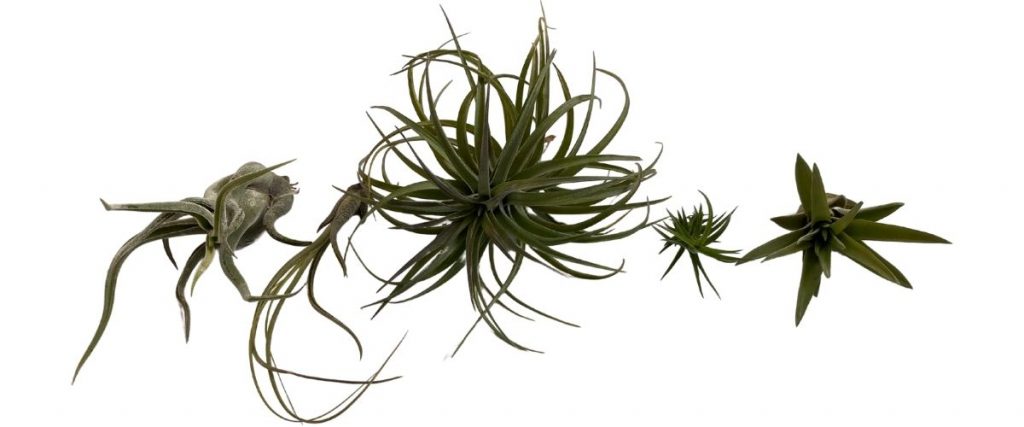
What are tillandsias?
Tillandsias, commonly known as air plants, are part of the bromeliad family. In addition, they are one of many examples of epiphytes, meaning that they grow on other plants and structures. However, epiphytes are not parasitic and do not take moisture or nutrients from their host. Instead, epiphytes use their leaves (instead of their roots) to absorb moisture and nutrients. Their roots are only used to attach to other surfaces. Tillandsias use trichromes, specialized structures on their leaves, to trap moisture and dust. Because they get all their nutrients from the atmosphere, they grow without the need for soil, hence the term “air plant.”
There are over 500 different species of Tillandsia which are native mostly to the southern United States, Central America, and South America. In nature, the mesic types attach to other plants, typically trees, in the rainforest canopy. The xeric types are from desert-like climates and typically attach to rocks.
Do tillandsias produce flowers?
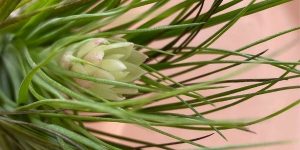
Not all tillandsias will flower indoors, but some will, and it may take years for this to happen. Blooming is the end of life for that individual plant, but typically blooming tillandsias will produce pups – small offshoots that will become full-grown tillandsias.
How can I display tillandsias?
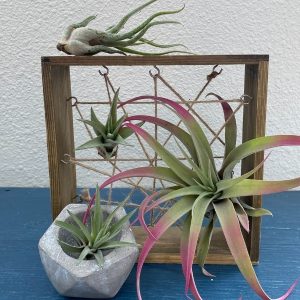
Because they do not require soil, tillandsias can be displayed in an infinite number of ways. They can be tucked into vignettes, tied on to displays using wire or string, and most are even happy in glass terrariums (so long as they get adequate air flow after being watered). It is best if the tillandsia can be removed from the display to be soaked in water, but it is possible to hydrate the tillandsia by misting it frequently (just be sure the mounting material does not hold water which could cause the plant to rot).
How do I care for tillandsias?
Since air plants typically receive bright, indirect light (for example, light filtered through a bit of the rainforest canopy), they prefer the same in your home. An east or west facing window is perfect!
In our dry Colorado climate, soaking is the best method for providing water to your air plants. Simply soak in a bowl of water for one hour, once a week. Then dry the plants upside down for a few hours to prevent the center from retaining too much moisture and rotting. Tillandsias appreciate good air circulation, but do not put them near a fan or heat vent where they might dry out too quickly.
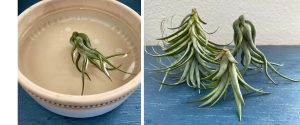
If the tips of the leaves become dry and brown, or if the leaves start to curl or roll, it may mean that the plant is dehydrated. If this happens, increase the humidity around your tillandsia by misting it with water on a regular basis or putting it in a terrarium.
While not required, tillandsias can benefit from light fertilization about once a month. Too much fertilizer can be detrimental to air plants, so it is best to use either an air plant specific fertilizer or dilute a typical houseplant fertilizer to about one-quarter of the suggested dosage. Apply the fertilizer by lightly misting the plant.
Visit us and find a new fabulous tillandsia to add a bit of flare to your home!
Resources
https://gardeningsolutions.ifas.ufl.edu/plants/houseplants/air-plants.html
https://extension.psu.edu/tillandsia-air-plants
https://aces.illinois.edu/news/tillandsia-air-plant-catching-eye-indoor-gardeners